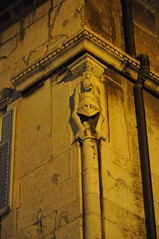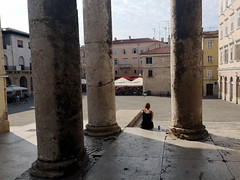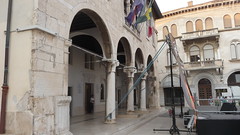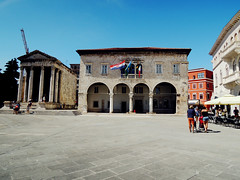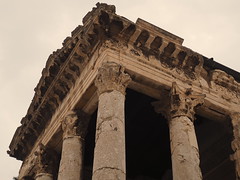Brijuni
The Brijuni (Serbo-croatian: [brijǔːni]) or the Brijuni Islands (also known as the Brionian Islands; Italian: Isole Brioni) are a group of fourteen small islands in the Croatian part of the northern Adriatic Sea, separated from the west coast of the Istrian peninsula by the narrow Fažana Strait. The largest island, Veliki Brijun Island (also known as Italian: Brioni Grande or Croatian: Veli Brijun), (5.6 km2), lies off the coast. The second largest island is Mali Brijun with an area of 1.07 km², and twelve much smaller islands. Famous for their scenic beauty, the islands are a holiday resort and a Croatian National Park.
The islands gained worldwide fame in 1956 when the main leaders of the Non-Aligned Movement met with the host, Yugoslav president Tito, to form the Brioni Declaration which served as the foundation for the policies the movement would follow. Another event which took place on the islands was the 1991 Brioni Agreement.
History
The Brijuni islands were called by ancient Greeks Pollariae or Pullariae (Πολλάριαι), and later, they were called Brioniano.
The Brijuni Islands had some Ancient Roman settlements, but up to the late 19th century the islands were mainly used for their quarries, which have been worked on for centuries. The islands belonged to Venice from the Middle Ages, and stone from the islands was used to build the palaces and bridges of the city. The islands were part of the Illyrian Provinces after Napoleon's brief annexation.
In 1815 the islands became part of the Austrian Empire, which later became Austria-Hungary. During this period the islands' quarries first supplied stone to Vienna and Berlin. With the erection of a naval base in the harbour of Pula, the Austrians built a strong fortress, "Fort Tegetthoff," on Veliki Brijun Island Island, together with minor fortifications on some of the others.
The Austro-Hungarian Navy abandoned the fortress, and in 1894 the Viennese business magnate Paul Kupelwieser bought the whole archipelago and created an exclusive beach resort. In 1900 Kupelwieser invited Robert Koch, the renowned microbiologist, to conduct his malaria eradication experiments on Brijuni. Koch and his associates were successful, and in 1901 the island was declared malaria-free.
The estate was supplemented with first class hotels, restaurants, beach resorts, a casino and a yacht harbour and became a focal point in social life on the Austrian Riviera. Kupelwieser also established a sailing regatta, a golf course and – due to the flourish of Austrian Culture – various musical concerts and literature events. The Brijuni islands became popular as a destination for the Viennese upper class and were visited by members of the Imperial family and other wealthy European bourgeois and aristocrats. During The Great War the Austro-Hungarian navy had a submarine base here.
In 1918 after World War I Brijuni became part of the state of Italy. Karl Kupelwieser, the son of the founder of the estate tried to maintain the former splendor, but after the economic crisis following the Wall Street Crash of 1929, the estate went bankrupt and Karl committed suicide. In 1930 ownership of the islands was acquired by the Italian government due to the bankruptcy, and they remained part of Italy until the capitulation in 1943.
In 1945 after World War II the Brijuni became part of Yugoslavia and President Marshal Josip Broz Tito made the Brijuni Islands his personal State Summer Residence. Slovenian architect Jože Plečnik designed a pavilion for Tito. Almost 100 foreign heads of state visited Tito on his islands, along with film stars including Elizabeth Taylor, Richard Burton, Sophia Loren, Carlo Ponti, and Gina Lollobrigida. Tito died in 1980, and by 1983 the islands were declared a National Park of Yugoslavia.
In mid-July 1956, President of Egypt Gamal Abdel Nasser, Prime Minister of India Jawaharlal Nehru, and President of Yugoslavia Josip Broz Tito met here to discuss their opposition to the Cold War. These ideas later crystallized into the Non-Aligned Movement. Vijay Prashad has compared this meeting to the Yalta Conference. Brijuni Islands were initially considered to host the 1st Summit of the Non-Aligned Movement yet the City of Belgrade was ultimately selected due to Brijuni's insufficient venues and concentration of the international communication and media facilities in the capital city of Yugoslavia. Brijuni hosted the 1987 Mediterranean Non-Aligned Countries Ministerial Meeting as well.
In 1991 Croatia gained independence and made the Brijuni Islands an International Conference Center (see Brioni Agreement). Four hotels on Veliki Brijun Island were re-opened, as well as a Safari Park, which holds animals given to Tito, such as Sony and Lanka, two Indian elephants donated by Indira Gandhi. Sony, who was donated to Tito in 1970 as a two-year-old calf, died in 2010. The International Brijuni Polo Tournament, dating back to Karl Kupelwieser's Austro-Italian Brijuni in 1924, has been re-continued since 2004.
Tourism
On the Brijuni there are several archaeological and cultural sites.
At four sites on Veliki Brijun Island over 200 dinosaur footprints have been discovered, which can be traced to the Cretaceous Period from where Brijuni Cretaceous Park gets its name.
The island encompasses several archeological sites. There is the 13th century AD St. Mary's Church which was built by the Knights Templar. There are also two ancient Roman villa remains, from the 2nd Century BC and remains of a Byzantine fort. The last remain is Hill-fort which indicates a Bronze Age settlement on the island dating back to 14th century BC.
The island houses an exhibition dedicated to Josip Broz Tito, showcasing photographs of more than a hundred state visits to the island. The lower floor of the museum is dedicated to stuffed animals, derived from the island's zoo.
There are also several exhibitions including natural history and art exhibitions, and archaeological collections.
Other
The Italian clothing company Brioni is named after the Italian name for the islands.
James Joyce celebrated his 23rd birthday on Veliki Brijun on 2 February 1905








